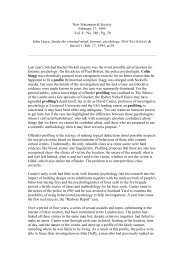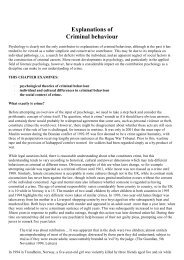Ch 11 - Jeff Standen
Ch 11 - Jeff Standen
Ch 11 - Jeff Standen
Create successful ePaper yourself
Turn your PDF publications into a flip-book with our unique Google optimized e-Paper software.
Models of abnormality<br />
John Bowlby's work on attachment (see <strong>Ch</strong>apters 4 and 5)<br />
was influenced by object relations theory.<br />
0B Treatment and the psychodynamic model<br />
Psychoanalytic treatment is designed to uncover repressed<br />
impulses and traumatic memories and bring them to<br />
conscious awareness. Freud's favoured method was to focus<br />
on the patient's dreams. He believed that dreams contain<br />
repressed material in a disguised form (Freud, 1900).<br />
Psychoanalysis invites patients to free associate on<br />
dreams, neurotic symptoms or childhood memories. Free<br />
association involves the patient letting their mind wander<br />
freely and saying whatever comes into their head. This in<br />
itself often uncovers repressed events and exposes<br />
uncomfortable desires. The psychoanalyst interprets the<br />
patient's words, dreams and behaviour, identifying and<br />
challenging their defence mechanisms.<br />
Bringing repressed material to consciousness is a painful<br />
process and leads to the release of pent-up emotion. This<br />
process is known as catharsis. Neurotic symptoms should<br />
now disappear, leaving the patient with conscious<br />
awareness of what they had tried to repress. The patient is<br />
now able to grow out of their childish fears and anxieties,<br />
working through the repressed material, making sense of<br />
their experience, and coming to terms with it.<br />
An important sign that therapy is actually taking place is<br />
when the patient engages in transference. This involves<br />
transferring repressed feeling towards others - for example,<br />
parents and siblings - in the patient's life, and 'taking them<br />
out' on the analyst. The patient loves, hates, fears or<br />
provokes the analyst, displacing pent-up feelings on to the<br />
analyst. When transference is over, psychoanalytic therapy<br />
is complete. The ultimate aim of psychoanalysis is to make<br />
the unconscious conscious, to cure neurotic symptoms, and<br />
to help the patient gain greater insight and self<br />
understanding.<br />
Evaluation of the psychodynamic model<br />
The psychodynamic model differs from the biological model<br />
in several important ways.<br />
• It rejects the biological model's view that abnormality is<br />
sharply distinct from normality. Everybody suffers from<br />
mental conflicts, but some are more extreme than others.<br />
• It does not try to explain psychological disorder in terms<br />
of brain dysfunction or inherited predispositions.<br />
• It considers drug treatments, shocks and brain surgery as<br />
unhelpful in getting to grips with the underlying causes<br />
of psychological disorders.<br />
• The psychodynamic model was more optimistic than<br />
early 20th century psychiatry, and held out the promise<br />
that some disorders at least could be cured.<br />
• Although it accepted the broad outlines of psychiatric<br />
classification, the psychodynamic model has always<br />
focused on the individual case. Two people may be<br />
depressed, but their depression may have very different<br />
origins and meanings, and simply to label both as having<br />
'mood disorder' does not get us very far.<br />
In one important respect the psychodynamic model<br />
resembled the biological model. It retained a doctor-patient<br />
relationship, with the psychoanalyst taking the role of the<br />
professional and the patient seeking expert guidance.<br />
The psychodynamic model is very controversial. It has<br />
been supported for producing powerful insights into the<br />
human mind and dismissed as little more than fantasy. First<br />
the criticisms.<br />
It is unscientific Evidence supporting the psychodynamic<br />
model comes from clinical case studies of individual<br />
patients. These studies rely heavily on the therapist's<br />
interpretations and are open to bias. They are largely based<br />
on information acquired retrospectively - adults recalling<br />
their early years. The accuracy of childhood memories is<br />
open to question. In addition, concepts like Id, Ego and<br />
Superego and processes such as repression cannot be<br />
directly observed and measured. According to the<br />
philosopher Karl Popper (1959), psychodynamic theory fails<br />
to produce testable hypotheses and is simply not scientific.<br />
Freud was quite prepared to go beyond empirical<br />
evidence - 'hard facts' and observable and measurable data<br />
- if his theories produced greater meaning and insight. If his<br />
findings could not be confirmed in the laboratory, then that<br />
was just too bad. For Freud, supporting evidence from<br />
Shakespeare's plays was of much greater significance than<br />
evidence from experimental psychology. Kline (1988; 1989)<br />
claims that there is strong evidence to support Freud's<br />
theory from real life, and that experimental psychology has<br />
yet to find a way of evaluating psychodynamic theory.<br />
It does not work Eysenck (1952) published figures which<br />
suggested that psychodynamic therapy was worse than<br />
useless in the treatment of psychological disorders.<br />
However, this claim has been questioned. Psychoanalysis in<br />
the USA has been attacked as little more than a money<br />
spinner with some people spending their entire adult lives in<br />
analysis - which costs them a fortune. However, Freud's<br />
own cases usually lasted only a few weeks. And some<br />
recent studies suggest that short-term psychodynamic<br />
therapy can be beneficial to some patients (Messer et al.,<br />
1992).<br />
It is deterministic and pessimistic Freud's theory has been<br />
criticised for suggesting that people's lives are dominated by<br />
unconscious drives and childhood experiences. Critics argue<br />
his theory is pessimistic because it offers little escape from<br />
these determining influences - people are pictured as<br />
prisoners of their drives and early experiences. However,<br />
Freud argued that this only happens if these factors are<br />
repressed. The whole point of psychoanalysis is to give<br />
people greater insight and the freedom to take control of<br />
their lives. Freud does claim that people have antisocial<br />
sexual and aggressive desires. But, in a more optimistic







